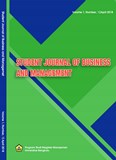Main Article Content
Abstract
Employee performance; To determine the effect of personality and work engagement on the performance of the Bengkulu Province Education and Culture Office. This research uses survey research method. The data collected was then analyzed using multiple linear regression analysis with dummy variables, and tested with the T test and F test. The results showed that: Big Five Personality has a significant effect on employee performance, work engagement has a significant effect on employee performance, big five personality and work engagement has a significant effect on employee performance at the Bengkulu Province Education and Culture Office. Based on the discussion and research conclusions, some suggestions that can be given related to the big five personality, work engagement and employee performance at the Bengkulu Province Education and Culture Office are: the dummy variable that is owned should be maintained. To improve employee performance, leadership should pay attention to the personality of openness to experience/openness to new things outside the field of education if it is not placed by the education sector, by holding training programs by the job desk given to understand its functions. and employee duties of course. can also improve employee performance. The results of this study are very useful for superiors in increasing employee work involvement. Superiors can do this in a work program that requires cooperation so that it can lead to employee work involvement in work so that it can indirectly improve employee performance in achieving the goals of the Bengkulu Province Education and Culture Office in the future.
Keywords: Big Five Personality (X1), Work Engagement (X2), Performance (Y)
